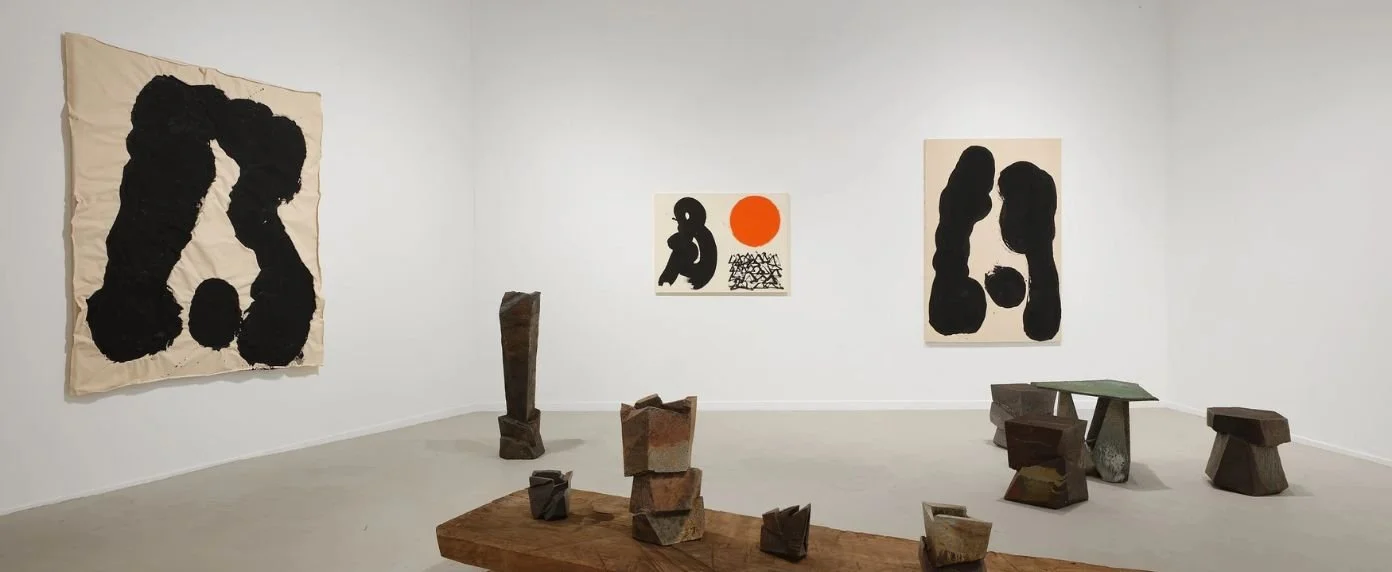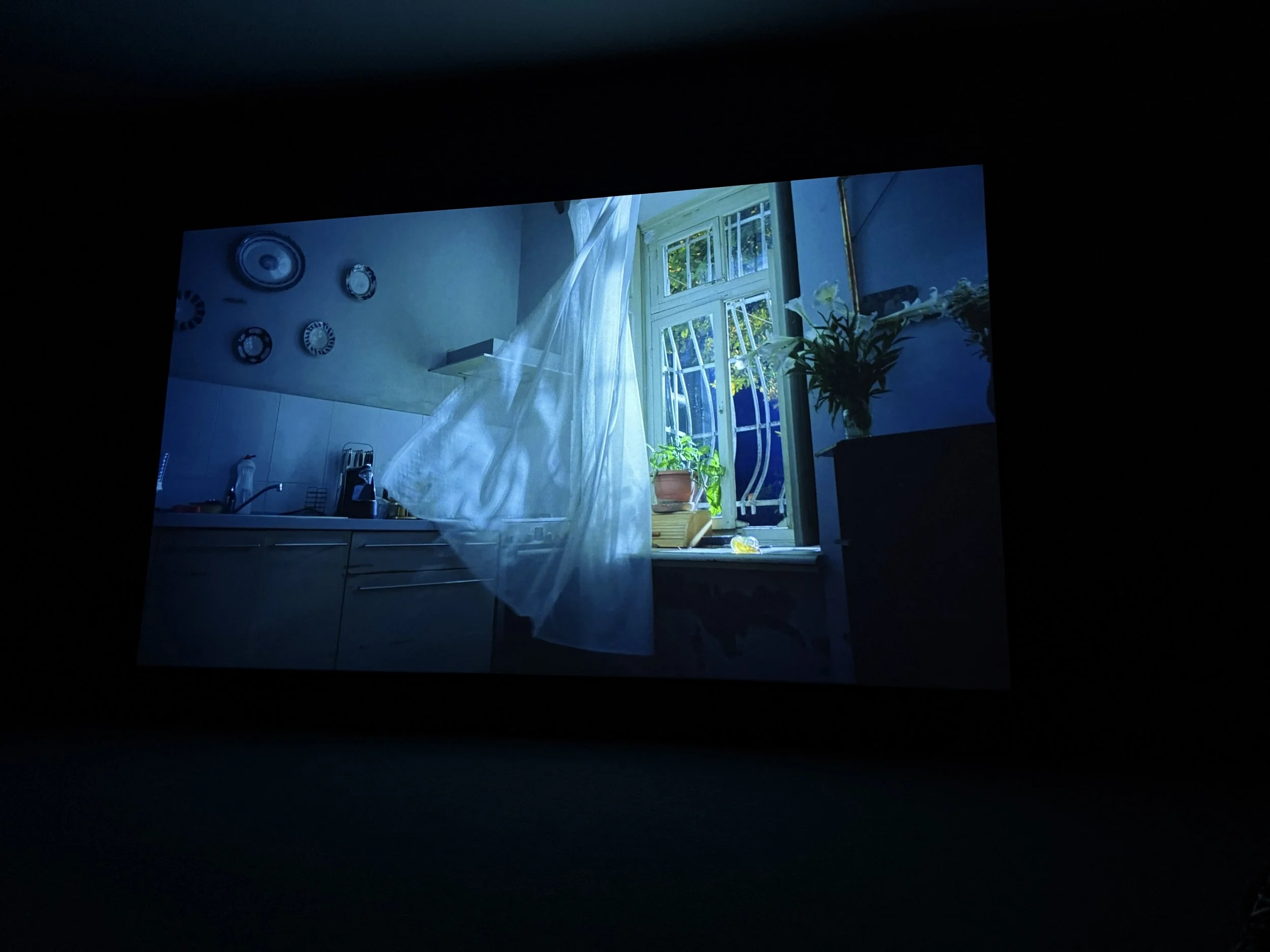Like A Summer Thursday: An Alternative Art Loop
Daichiro Shinjo and Jonathan Cross, 2025. Installation view, 2025. Courtesy of the artists and JB Blunk Estate.
“So like a summer Thursday, I cry for rain
To come and turn the ground to green again.”
-Townes Van Zandt
During the Bay Area’s coldest summer in decades, I spent countless hours nestled in Mill Valley’s castellated library, followed by hikes through nearby resplendent forests. On one of those fawn-ridden sojourns in early June, I happened upon a bush of aubergine seed pods belonging to the indigenous Silver Bush Lupin. I plucked two clusters, later to be spotlighted in a ceramic wall vase in my living room.
Just as I sat to write this, a violent pop and then the sound of metal bones cracking. The noise came from the direction of my heater, recently indoctrinated by the first rain of fall. Following the direction of the unidentifiable ruptures, several seed pods burst into my face, before clattering against the steel box below and crackling across the wooden floor. Here was the temporal change, the season’s end, a not all too common feeling for this Bay Area native, provoked by that of another.
In response (and perhaps in gentle rebellion) to recent discussions around the Big–with a capital B–Art Loop, I want to offer a guide to subtle, unassuming exhibitions featuring photography, sculpture, film, painting, and ceramics across the Bay Area. These six artists breach the divide between our inner worlds and immediate environments from various vantage points. These past few weeks, I explored the nooks and crannies of the Bay Area art scene, gathering artists whose work explores transitions of every kind.
The first stop is a true hidden gem. A gallery situated a little ways from downtown San Francisco, Book and Job presents local artist Asako Shimazaki’s first solo exhibition of black and white silver gelatin photographs. These works were made during the 1990s as Shimazaki traveled back and forth from America to Japan. She had recently moved to San Francisco to attend SFAI, where she studied with local legend Henry Wessel.
Asako Shimazaki, Ayu no Kaze, 2025. San Francisco 2025. Courtesy of the artist and Book & Job Gallery.
In this series titled Ayu no Kaze, Shimazaki reflects on the changing of seasons in Japan, the title pulled from an ancient sailor’s phrase, meaning “the wind of promise.” Asako seamlessly pairs images of snow-laden rooftops, a misty window’s curtain swept just so slightly, with uncanny, summery scenes. A splattering of plastic cartoonish birds in a fenced-off front yard lined with train tracks to nowhere sit across from an image of giraffes gazing this way and that. Peering through fences, foggy windows, cascading leaves, and scattered sky cut from the heaving weight of the mountains, familiar landscapes become fantastical, rendered from the artist’s incantatory perspective. Asako reminds us, “no matter the changes in our lives and culture, ‘Ayu no Kaze’ returns every year. It speaks to [us] of eternity.” Seasonably well-timed, this series questions what changing incoming tides have to offer as some of us (me) begrudgingly saunter from summer to fall.
After subliming into Shimazaki’s heavenly tableaus, slip back into the city and under the primordial trees at the recently renovated Transamerica Redwood Park. Twelve bronze sculptures by Max Ernst linger in the shade of the trees and towering pyramid, a cohesive cohort presented by Gallery Wendi Norris, in partnership with SHVO.
Max Ernst, Bronze Sculpture, 1938.San Francisco, 2025. Photo: Janie Perez-Radler.
Crafted by Ernst in 1938 during his time living with his then lover, Leonora Carrington in the south of France, these sculptures strolled out of the illicit couple’s surrealist hideaway (forty-six-year-old Ernst having left his wife for the 20-year-old Carrington). Born in that romantic summer domesticity, these works frolic happily under the trees in this pocket forest. Don’t miss the sculpture tucked away inside TransAmerica architect William Pereira's pyramid, suspected to have been made collaboratively with Carrington. In this serene pseudo-nature reprieve, Ernst’s and Carrington's ill-fated fairy tale lives on.
Another bridge beyond, the surrealist wave crests into Georgian artist Andro Eradze’s dreamy, fabulist animism at the Berkeley Art Museum. His trilogy of films, recently debuted at BAMPFA’s Matrix Gallery and curated by BAMPFA chief curator Margot Norton, invites a recumbent viewing, with pleather cushions scattered on the gallery floor below a 10ish-foot-wide screen.
Andro Eradze, Shifting Stillness, 2025. Still image, Berkeley Art Museum and Pacific Film Archive, 2025. Photo: Janie Perez-Radler.
The films begin with an all-encompassing cacophony of binaural tones entangled with familiar murmurs of wind, fire crackling, and sounds of a far-off carnival. These eldritch utterances dance beautifully in tandem with the stark red, green, and blue flickers of light. William De Kooning once said in an interview from 1960 with David Sylvester, “Content is the glimpse of something, an encounter like a flash. It’s very tiny—very tiny, content.” The beauty of Eradze’s landscapes is undeniable, but they’re nevertheless a frantic, unreliable narrator at best. A display of a zoo of taxidermy huddled in a dark forest, followed by floating kitchen utensil buffoonery, one’s senses are heightened beyond belief as a comical arc meets an experimental conjuring, an unlikely but exceedingly entertaining marriage.
Delightfully depleted, it might be time to retreat up north to idyllic Marin. Nestled in the heart of downtown Point Reyes, the ever-lovely Blunk Space is an artful extension of the artist’s handmade home, currently exhibiting work by Daichiro Shinjo and Jonathan Cross.
Daichiro Shinjo and Jonathan Cross, 2025. Installation view, 2025. Photo: Janie Perez-Radler.
Shinjo is based in Okinawa, Japan, and Cross in Wonder Valley, California. They both take direct inspiration from JB Blunk and the very land in which he crafted his house and much of his life’s work, a modernist atavism of gorgeous wood carvings and shapely clay forms. Made on the literal grounds of Blunk’s homestead, these large paper works hold the impression of the warm Inverness dirt, a mold of the piece’s own birth. The paper curls around stark black, deliberate brushstrokes and dries before being forever mounted to canvas.
Daichiro’s muted tangerine sun in the center of the room casts the shadow that is Jonathan Cross’s ceramic pieces lining a piece of wood that feels like it organically emerged from the gallery floor. And in some ways, they did. Cross harvested clay from the same grounds that JB once scavenged for his own pieces. Shinjo’s round shapes perfectly complement the angular shapes of Cross ceramic vessels and furniture. All three artists work intuitively, but also with a deep, profound knowledge of material. It's only when one has this level of sapience that works can be produced from single gestures or the unpredictability of firing unfamiliar types of clay. These contemporary artists infuse their backgrounds and cultures with that of the legacy of JB Blunk, yielding a harmonious collaboration.
After the woodland idylls, the city beckons. I welcome you to say hello to me at Casemore Gallery, where I currently serve as the Associate Director. Our current exhibition, Daido Moriyama: Dog and Man fuses both the meditative elements of Shiniro, Jonathan, and Asako’s work with the intense jolt of Andro's vertiginous visuals. With a focus on the bustle and speed of Tokyo, Moriyama here moves through the world at an expedited pace. The revolutionary “rough, blurry, out-of-focus” of his early work from the 1960s and 70s balances against the blocked-out wall of side-by-side, more recent, rarely seen color prints.
Daido Moriyama, Dog and Man, 2025. Installation view, San Francisco, 2025. Photo Courtesy of Casemore Gallery.
The historic black-and-white silver gelatin prints from the 1960s and 1970s were printed by Moriyama himself (now in his late 80s), a feat he hasn’t undertaken since the early 2000s. From a young child running in front of a cherry blossom tree to an obfuscated self-portrait in a dirty mirror, these aren't images Moriyama could have made moving in the same way as his newer work. The iconic Japanese photographer captures life at its pace. Moving from summer to fall, from Mill Valley to San Francisco to Berkley and back, life has its different paces, each hour inviting a new rhythm. A subtlety better marked by these artists in direct conversation with their surroundings than by the well-intentioned blockade malingering along the San Francisco waterfront.
Before retiring to bed, I remove the Lupin branches from the wall vase in which they sat since the beginning of summer. The leftover seed pods resemble frozen caterpillars, their indigo backs delicately lined with white fur, and bodies sometimes twisted to the point of just barely hanging onto their branches. I place them atop my fridge so as not to be awoken by the sounds of summer’s denouement. Another part of me maybe doesn’t want to let go of the heat quite yet.
- Janie Perez-Radler
Ayu no Kaze, Asako Shimazaki: Book and Job Gallery through October 24
(Closing reception: October 24, 6-9 pm)
Max Ernst, Transamerica Pyramid Center, On view through December 14
Andro Eradze: Shifting Stillness, BAMPFA, On view through December 21
Daichiro Shinjo and Jonathan Cross, Blunk Space, On view through October 25
Daido Moriyama: Dog and Man, Casemore Gallery, On view through November 1






